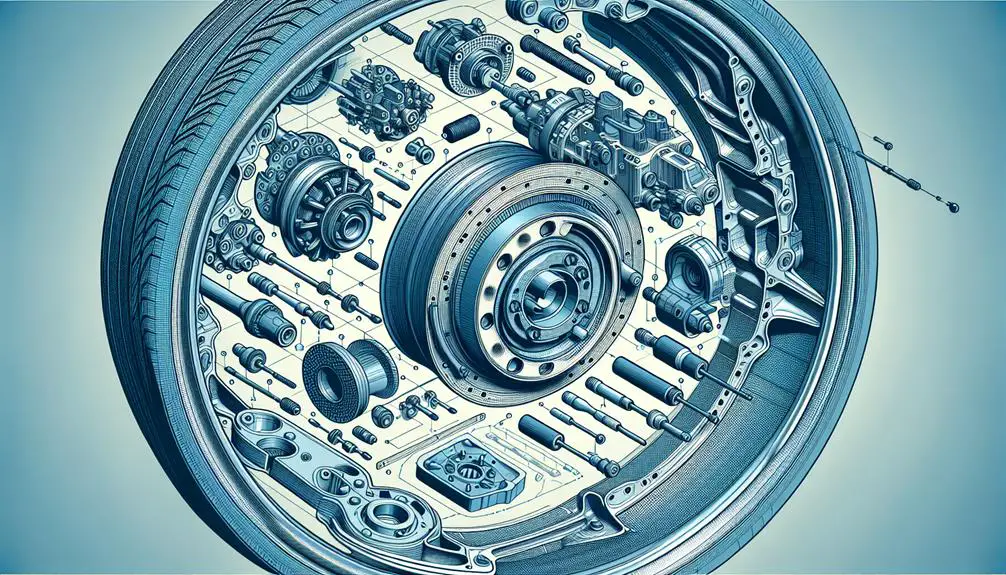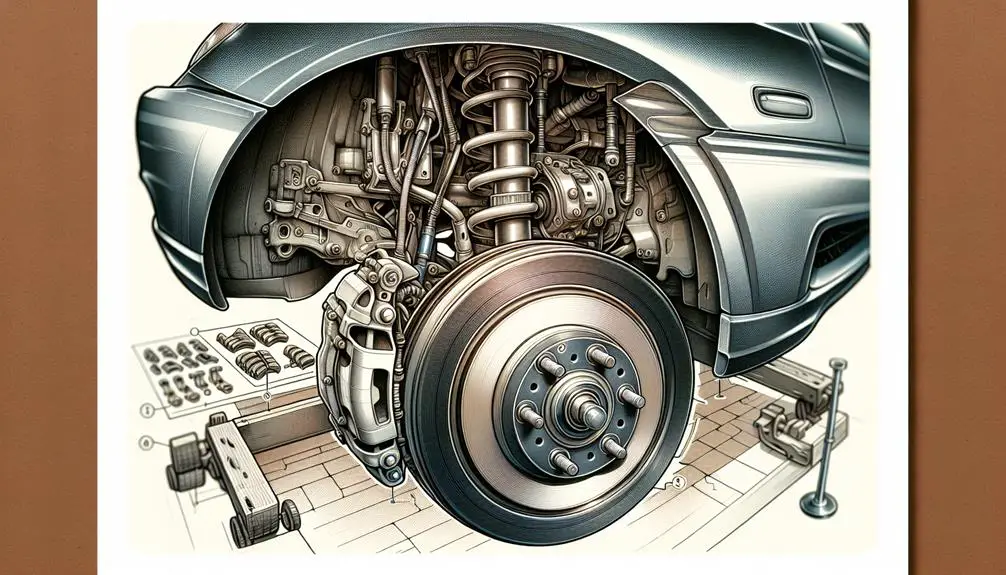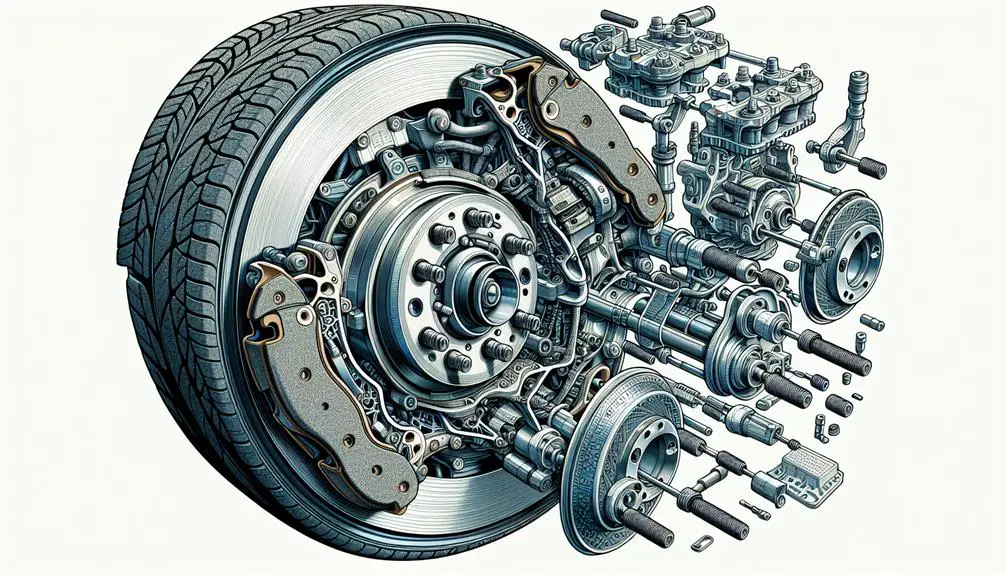Brake shoes are responsible for pressing against the brake drums to create friction and slow down the vehicle.
They are activated when the brake pedal is pressed, causing them to rub against the inside of the drum and create the necessary resistance to stop the car.
Brake shoes need to be regularly inspected and replaced when worn out to ensure optimal braking performance and safety.
Understanding Brake Shoes

Brake shoes are crucial components in a vehicle's braking system, directly responsible for slowing or stopping your car. They're typically found in vehicles with drum brake systems, not in those with disc brakes. You'll find them sitting inside the brake drum, playing a critical role every time you press the brake pedal.
When you hit the brake, hydraulic pressure forces the brake shoes against the drum, creating friction. It's this friction that slows down your vehicle, making brake shoes a pivotal safety feature. Over time, the friction material on the shoes wears down, which means they'll need replacing to ensure your brakes remain effective.
You mightn't think about them often, but maintaining your brake shoes is vital for safe driving. Waiting too long to replace worn shoes can lead to decreased braking performance and potentially dangerous situations. It's a good idea to have them checked regularly as part of your vehicle's maintenance routine.
Drum Brakes Explained
Comprehending the role of brake shoes sets the stage for exploring how drum brakes, the system they operate within, function to keep you safe on the road. Essentially, when you press the brake pedal, a series of mechanical actions slow your car down. Drum brakes, which house the brake shoes, are an essential part of this process.
Drum brakes work by pressing the brake shoes against the inside of a rotating drum attached to the wheel. This friction slows the wheel, thereby slowing your vehicle. It's a simple yet effective mechanism that's been used for decades.
To give you a clearer picture, here are key elements of drum brakes:
- Brake Drum: The circular drum that rotates with the wheel.
- Brake Shoes: These press outward to create friction against the drum.
- Wheel Cylinder: Activates the brake shoes.
- Brake Return Springs: Pull the brake shoes back when you release the pedal.
Understanding these components helps you appreciate how essential they're to your safety. Each part works in harmony to ensure that your vehicle stops when you need it to, highlighting the importance of regular maintenance and inspection.
Location in the Vehicle

You'll typically find the brake shoes located within the drum brakes at the rear wheels of your vehicle. This setup is a bit traditional but very important for vehicles that don't require the intense braking power of more modern braking systems like disc brakes. The brake shoes play a vital role in your vehicle's ability to stop safely by pressing outward against the drum that spins along with the wheel.
Comprehending their location helps you grasp their function and significance. Here's a simple table to illustrate key aspects related to the brake shoes' location:
| Feature | Description |
|---|---|
| Position | Rear wheels |
| System | Drum brakes |
| Function | Create friction |
| Maintenance | Regular check-ups |
This table highlights the important elements about where brake shoes are located and their role in your vehicle. Remember, even though they're out of sight, they shouldn't be out of mind. Regular maintenance and check-ups are important to make sure they're always in top condition, contributing to your vehicle's overall safety and performance.
Differences in Modern Cars
How do modern cars differ in their braking systems, especially in the context of brake shoes? You'll notice that as technology has advanced, the braking systems in modern vehicles have seen significant changes. While brake shoes are still used, their application and technology have evolved.
Most modern cars now primarily use disc brakes for the front wheels, which are more efficient for the high-performance demands of today's driving. Brake shoes are primarily found in the rear brake system, especially in vehicles equipped with drum brakes. Here's a quick rundown of key differences:
- Disc vs. Drum: Modern cars often feature a combination of disc brakes at the front and drum brakes, with brake shoes, at the rear.
- Material Innovations: The materials used in brake shoes have improved, offering better heat dissipation and longer wear life.
- Electronic Brake-force Distribution (EBD): Modern vehicles use EBD systems that adjust the braking force between the front and rear brakes, optimizing the use of brake shoes in vehicles that still have them.
- Regenerative Braking: Some hybrid and electric vehicles use regenerative braking systems that reduce the reliance on traditional brake shoes for slowing down.
As you can see, while the role of brake shoes has changed, they remain an integral part of the braking system in many modern cars, albeit with updated technology and applications.
Maintenance and Replacement

Maintaining and replacing your car's brake shoes is crucial for ensuring optimal braking performance and safety. Regularly checking them for wear and tear can save you from unexpected brake failures and potentially hazardous situations. It's not just about safety though; it also aids in keeping your vehicle's braking system efficient and responsive.
Here's a quick guide to help you understand when it's time for maintenance or replacement:
| Sign | Maintenance Needed | Replacement Needed |
|---|---|---|
| Wear Indicator Noise | Inspect brake shoes | Replace if below minimum thickness |
| Pulling to One Side | Check for uneven wear | Replace if one side is significantly worn |
| Increased Stopping Distance | Clean and adjust brake shoes | Replace if cleaning doesn't improve performance |
| Spongy or Soft Brake Pedal | Inspect for contamination or wear | Replace if contaminated or worn out |
Always remember, if you're unsure about the condition of your brake shoes or how to proceed with maintenance or replacement, it's best to consult a professional. They can provide you with the right advice and ensure that your car remains safe to drive. Keeping up with regular maintenance will not only extend the life of your brake shoes but also help in maintaining the overall health of your car's braking system.
Conclusion
You've now explored the world of brake shoes, having a good grasp of their role in drum brakes and their location in your vehicle.
While modern cars might often sport disc brakes, it's important to keep in mind that many still rely on brake shoes for the rear wheels.
Don't forget, keeping an eye on their condition is important for your safety on the road. Regular maintenance and timely replacement will make sure your brakes work effectively, keeping you and others safe during your travels.